| 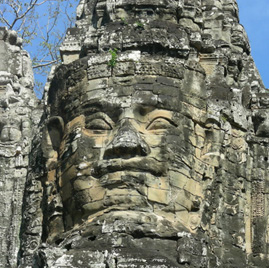
 Karen's Perspective on Traveling
Alone Karen's Perspective on Traveling
Alone






















|
I returned to Spain after a 40 year hiatus and made my pilgrimage to see Guernica at the Reina Sofia
museo in Madrid. I wish I had kept a travelogue at 18 when I first saw this indictment of war
painted by Picasso during La Guerra Civil. I know it shook the core of the sheltered but curious
West Texas girl I was and I've been trying all my vida like you to understand violence and its
origins. My conclusion then and now is that patriarchy, greed and a deep alienation from nature are
the culprits. Picasso's enormous sized mural retained its power for me and the audience of mostly
young viewers. I had stayed at Hotel Paseo del Prado right across from the Prado after a false start
at a local hostel whose dark and cramped rooms reminded me that all hostels are not created equal,
especially when one is 58.
I headed south on the train to Granada and my Spanish was passable, which was a relief with only
funny misunderstandings at times. Spain deserves its stereotype for its sunny disposition but having
traveled from SE Asia to Latin America and Africa I could not have anticipated how much truth there
is in that overall impression. Granda and Madrid seem so "civilized" as compared to most of my
travels (and especially in the U.S.) The landscapes and most folks I see on the "gringa" trail are
so pleasant, the architecture and details so aesthetically pleasing but not in that stuffy Northern
European or San Francisco way that speaks only money to me. Here it's passion mixed with a
romanticism and a heartfelt nod to tradition that had me in tears at my first live flamenco
performance in the Albaicin (Muslim quarter). Maybe the tears were a reaction to feeling so
intensely alive when close friends are dying or as Lonely Planet describes: "unmasking the
intangible spirit of duende?"
I make myself at home with young people as this middle-aged woman
roams the cobblestoned streets at midnight and feels completely safe. The first night I missed my
date with the Alhambra as I fell asleep on the terraza of my airbnb in a chaise lounge and awoke 20
minutes later to the view. What a beginning to my love affair with the old world duende of Espana.
The next day I took the bus up the steep hill to the Alhambra with my reserved ticket. Four hours
later, after touring the Generalife (gardens) and the Alcazaba (citadel), I felt like I was finally
getting a dim understanding of what life might have been like during its heyday. As Wikipedia notes:
"It is a place where artists and intellectuals had taken refuge as the Reconquista by Spanish
Christians won victories over Al Andalus. The Alhambra integrates natural site qualities with
constructed structures and gardens, and is a testament to Moorish culture in Spain and the skills of
Muslim, Jewish, and Christian artisans, craftsmen, and builders of their era."
After all that walking I was ready to soak to soak my body and where else but Hammanandalus, a fancy
ass hamman lovingly restored whose origin is in the 13th century. The only bummer was that it's
co-ed (unlike the hammans of Istanbul) so I had to wear a stinkin' swimsuit but the sublime
architecture and mix of temperatures made up for it. Besides, if it were coed and desnuda, gay men
from all over the world would have taken it over by now as there would be a lot to admire, from
architecture to appendages. I missed my buddy Paul Backhurst as three somewhat attractive Arabic men
who with their beards looking like emirs entered the bath where I was. A long meaningful blink and
slight smile between us would have meant we were both thinking of a favorite movie "Turkish Bath".
I'm not sterotyping here--I asked them if they were Arabic Spanish and they were. First clue, the
beards and then the Arabic... (very politely hushed). A quick fact: Queen Isabel in particular had
been smitten by Granada - so fittingly named for the jewel-like pomegranate, she thought, its
buildings clustered like seeds along the hillsides - and she wanted it for herself.
I was seeing pomegranates in gardens and my airbnb host Isabel made me fresh pomegranate juice two
mornings. She was a like a character out of a Nadine Gordimer book and had lived in Capetown for 10
years, had five children, got divorced and came back to Granada to take care of her mom. We
immediately became fast friends and why I adore traveling alone. I spent too much time meeting with
a real estate agent and checking out potential properties to buy but I finally did find a total
fixer upper that had been abandoned more or less for 40 years with excellent "bones" in the Albaicin
and if I were to live in Granada it would have been a difficult but rewarding project.
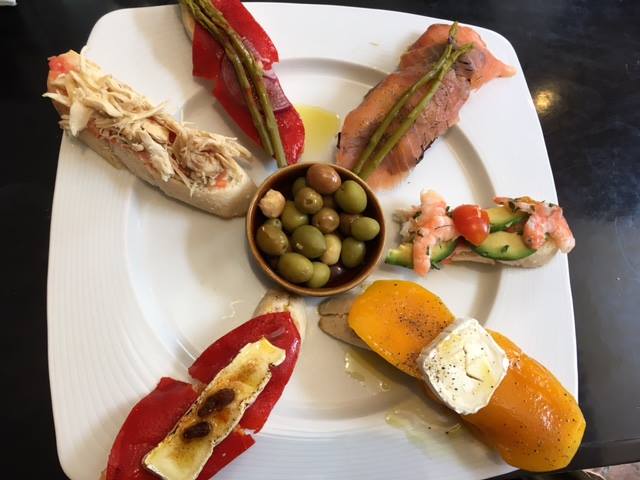 I found a great local tapas bar with no tourists and my new friends encouraged me to try the pulpo
(octopus) served on a bed of mashed potatoes and I became an immediate convert.
I found a great local tapas bar with no tourists and my new friends encouraged me to try the pulpo
(octopus) served on a bed of mashed potatoes and I became an immediate convert.
After two more days than I had expected to stay in Granada, I took the train to Cordoba, home to, of
course, the famous Mezquita (Mosque) with an enormous Gothic church built inside it. The light is
what captures one's imagination both inside the Mezquita and at sunset from the top of the Alcazar.
The Alcazar was the prison of the Christians during the Inquisition when most Muslims and Jews were
expelled or killed. Think 1492 and what was happening in the Americas. The river Gualdaquivir is
stunning and runs serpent like through the city. I visited the synagogue in the "Jewish quarter" but
it was the Sephardic Jewish Museum with its informative and well laid out displays that gave me the
context of what it must have been like for Arabs, Jews and Christians to peacefully coexist for
centuries in this crucible of learning and culture. One evening, I passed a protest for refugee
rights organized by Amnesty International with the same exhausting and boring speakers I might have
experienced at home.
I always use Lonely Planet as my guide and had read about the little village of Alájar in the
province of Aracena and made my booking at Posada San Marcos. I've stayed for about $85 a night
including breakfast and with a high level of sustainability plus wheelchair accessible.The landscape
reminded me of northern CA in the foothills of the Sierra and there was a tremendous drought so it
feels like CA until last winter. The difference here is the enormous number of historic sites
including castles, churches, and yes even limestone grottos which I knew nothing about until my
arrival. This area has the largest number of walking trails in all of Europe (or so I've been told)
Besides lynxes, there are foxes, tejones, (a nocturnal mammal in the bear family whose scat I saw),
Griffon vultures (which I spotted) and most famous, the Iberian pig which they eat here with a
intense rabidness. I must admit, I became something of an aficionado as it makes our pulled pork
sandwiches seem quite ordinary.
The first day I walked along a gorgeous country road from Alajar to Linares with benches and vistas
along the way and very few people, unlike the Camino de Campostela. By lunchtime I was hot and
famished and ate an amazing meal at Los Sentidos, a fairly high end restaurant in Linares before
heading back to the cool pool and hammocks of Posada San Marcos. The next days included a bird
watching expedition with an excellent local guide and all day sightseeing trip by car with Angel,
co-owner of Posada San Marcos with his English wife. Angel is a history buff and former teacher. We
visited several of the surrounding "pueblos blancos" and even saw one of the few remaining mosques
in the area. The highlight though was a guided tour of Las Grutas de Aracena, a cave system opened
in 1914 and the oldest in Espana. The color of the standing pools of water were vivid turquoise and
the grotto was found directly under a castle with roots in the Middle Ages.
Angel also explained the harvesting of the fairly common cork oak which only specialists can harvest
every 9 years to make cork for wine bottles, insulation etc. Angel detests silicon wine stoppers or
aluminum screw offs and really I can't blame him. Cork is a natural occurring substitute that has so
much history, even if finding a wine opener can be a bit of challenge sometimes.
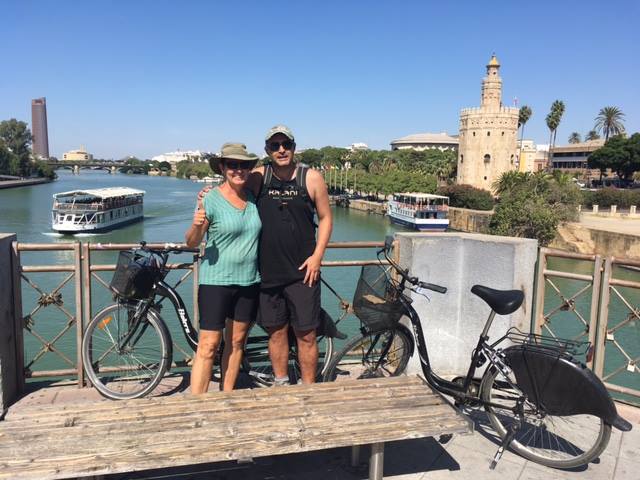 I took the bus onto Sevilla, the former capital of all of Europe, where I met up with Amir Fallah
from Vancouver that I had met the previous winter on the Big Island. We biked the city for 2 days,
the first day past the bridge over the Gualdaquivir with great views of the Torre del Oro. We were
in bike shorts, but no matter, we were invited in to enjoy perhaps the most expensive meal of the
trip at a riverside restaurant with ceiling to floor plate glass windows and AC for which we were
grateful. Coming back after visiting the Centro Andaluz de Arte Contemporaneo, I got a flat tire and
we waited out the siesta time for the local bike shop by having another quick drink. We stayed in
the historic center where we pondered the labyrinthine streets that make up the Santa Cruz
neighborhood, and ate my first paella (not from this region), washed down with our new favorite,
tinto de verano con limonada, basically a Kool-Aid type of grown up fruit drink with a splash of red
wine. We soaked in the exquisitely lit hammam of Aire Sevilla to get rid of those aches and pains
while listening to a guitar and flute duet playing bosso nova. Also had to go see another terrific
flamenco show. Olé! Si, la vida de la turista es bien difícil.
I took the bus onto Sevilla, the former capital of all of Europe, where I met up with Amir Fallah
from Vancouver that I had met the previous winter on the Big Island. We biked the city for 2 days,
the first day past the bridge over the Gualdaquivir with great views of the Torre del Oro. We were
in bike shorts, but no matter, we were invited in to enjoy perhaps the most expensive meal of the
trip at a riverside restaurant with ceiling to floor plate glass windows and AC for which we were
grateful. Coming back after visiting the Centro Andaluz de Arte Contemporaneo, I got a flat tire and
we waited out the siesta time for the local bike shop by having another quick drink. We stayed in
the historic center where we pondered the labyrinthine streets that make up the Santa Cruz
neighborhood, and ate my first paella (not from this region), washed down with our new favorite,
tinto de verano con limonada, basically a Kool-Aid type of grown up fruit drink with a splash of red
wine. We soaked in the exquisitely lit hammam of Aire Sevilla to get rid of those aches and pains
while listening to a guitar and flute duet playing bosso nova. Also had to go see another terrific
flamenco show. Olé! Si, la vida de la turista es bien difícil.
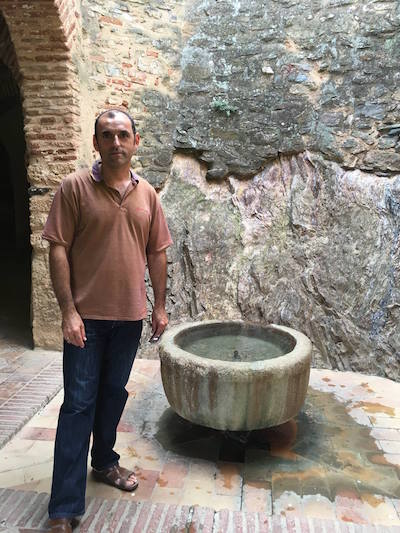 The second day in Sevilla was also a bike day and this time we hired a guide who took us to the
Plaza de Espana and also to the Universidad de Sevilla which was originally The Royal Tobacco
Factory when Sevilla was the prime manufacturer of cigars in Europe. The title character of Bizet's
opera Carmen is a cigarrera at the Royal Tobacco Factory. Off all the natural resources that the
Spaniards brought back from the New World, perhaps tobacco is the most wide-spread. A horrifyingly
large percentage of Spaniards still smoke and I saw mothers literally blow smoke into their kids
faces.
The second day in Sevilla was also a bike day and this time we hired a guide who took us to the
Plaza de Espana and also to the Universidad de Sevilla which was originally The Royal Tobacco
Factory when Sevilla was the prime manufacturer of cigars in Europe. The title character of Bizet's
opera Carmen is a cigarrera at the Royal Tobacco Factory. Off all the natural resources that the
Spaniards brought back from the New World, perhaps tobacco is the most wide-spread. A horrifyingly
large percentage of Spaniards still smoke and I saw mothers literally blow smoke into their kids
faces.
Amir and I took the train from Sevilla to the picturesque town of Ronda to meet up with our trekking
companion, Dan Galewsky whom we also met at Kalani, a retreat center on the Big Island. We were on a
self-guided seven day trek organized through explore.com and Ronda was our launching off point. We
explored the magic of Ronda, walking to the trickling water behind the "new bridge" in town and
having happy hour at a funky place to watch the sunset. Our taxi driver picked us up the next
morning and took us to Grazalema where we checked into our hotel and began watching the shenanigans
of the Bandalero (bandit) festival we had stumbled on. Rowdy men dressed the part and began holding
us up for money, brandishing knives and spears. I got into the act, feigning terror and having some
good laughs. It was all good fun until the same rowdies starting shooting off their cap guns, making
me jump involuntarily and hurting the eardrums of the populace.
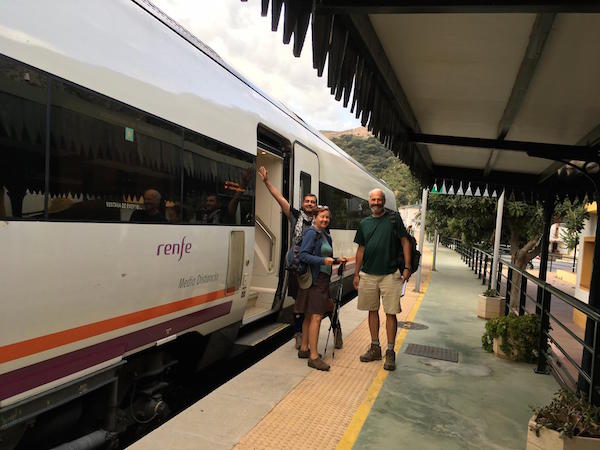 The next day we were supposed to trek from Grazalema to Benoacaz, a supposedly 5 1/2 trek. It
started out great with the cool of the morning and us following our maps and finding our markers,
which were mostly small signs along the way. But then we were stuck and we couldn't find the next
landmark. At the same time, Amir heard the bleating of a goat that had its head stuck in the barbed
wire and offered it some food. After we calmed it down, we jerked its horns and neck backwards and
were able to set it free. It felt gratifying as we saw it scamper away. Why do we have barbed wire
fences anywhere in the world? Then we were lost and made the mistake of not backtracking but going
blithely ahead. No one said it would be easy but I didn't expect to climb over a barbed wire fence
when we became "perdidos." Now we recrossed our steps back to close to the beginning at the car park
at El Boyar.
The next day we were supposed to trek from Grazalema to Benoacaz, a supposedly 5 1/2 trek. It
started out great with the cool of the morning and us following our maps and finding our markers,
which were mostly small signs along the way. But then we were stuck and we couldn't find the next
landmark. At the same time, Amir heard the bleating of a goat that had its head stuck in the barbed
wire and offered it some food. After we calmed it down, we jerked its horns and neck backwards and
were able to set it free. It felt gratifying as we saw it scamper away. Why do we have barbed wire
fences anywhere in the world? Then we were lost and made the mistake of not backtracking but going
blithely ahead. No one said it would be easy but I didn't expect to climb over a barbed wire fence
when we became "perdidos." Now we recrossed our steps back to close to the beginning at the car park
at El Boyar.
We hiked awhile longer and found the trail we had lost by waiting for hikers to see where they were
coming down and relying more on what we called "Karen's internal GPS." After a few more miles, we
again lost our way until Amir spotted a huge red arrow on the rocks. I scampered ahead and indeed
found the trail and was eager now to reach our destination but my posse was not inclined to push
ahead as they had run out of water. I felt a bit desolate but agreed it was time to give up for the
day, called our taxi driver who was waiting 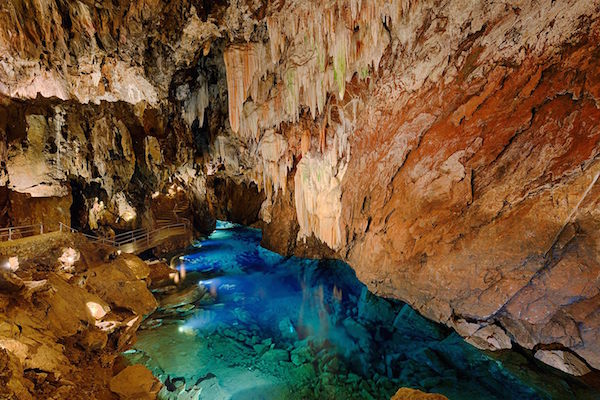 in the village where we were supposed to arrive and had
him pick up me and two other lost Scots after sending Amir and Dan back to town with some locals. in the village where we were supposed to arrive and had
him pick up me and two other lost Scots after sending Amir and Dan back to town with some locals.
In the next days we had a much easier time finding our way and hiked the dry landscape with cork
oaks and other varieties of spotty trees from Grazalema to Villaluenga del Rosario (about 10 miles)
and then took a taxi to Benoajan where we stayed in luxury at Hotel del Molino which had an amazing
location next to a flowing stream and served us creative surf and turf meals from an extensive menu.
I took an all day rest one day while the guys hiked up Cueva La Pileta and came down to meet me for
lunch. Turns out they had met a lesbian couple from Oakland who would be coming to the hotel for
lunch and of course, the ending to the story was that I knew them, Lisa Vogl and her longtime
girlfriend.
It was disconcerting to read about the devastating hurricane in Puerto Rica as well as the continued
natural disasters coming out of Baby President's mouth. But such is life.We also visited Cueva La
Pileta (an prehistoric cave) and saw pictographs of fish, horses and even a seal plus writing from
40,000-5,000 years ago. Cadavers and pottery from this cave are in museums throughout the world and
it was a fierce reminder of how long we have survived (and unfortunately dominated) as a species.
We walked our last triumphal trek up the moderate incline over a saddle in the mountains from
Montejaque to Ronda. We enjoyed seeing mountain goats and I wished my footsteps were so light and
graceful. Luckily an old man pointed out a fountain of fresh cool water just as we started the steep
ascent to the historic town center. It certainly rejuvenates the soul to be in a culture so in touch
with nature and family/friends as the Spanish are.
 The next day we biked 25 miles along the Via Verde (thanks Franco for perhaps the one nice thing you
ever did in your sorry life) with no cars and maybe 10 tunnels, one at least a mile long I think.
Think serious Rails to Trails. Because the Spanish are so civilized, there were a few cafes along
the way and even an overnight pension. Griffon vultures perched high in the cliffs at one stop along
the way and the slight breeze was a welcome relief from the stagnant hot air of the afternoons in
the previous days of hiking.
The next day we biked 25 miles along the Via Verde (thanks Franco for perhaps the one nice thing you
ever did in your sorry life) with no cars and maybe 10 tunnels, one at least a mile long I think.
Think serious Rails to Trails. Because the Spanish are so civilized, there were a few cafes along
the way and even an overnight pension. Griffon vultures perched high in the cliffs at one stop along
the way and the slight breeze was a welcome relief from the stagnant hot air of the afternoons in
the previous days of hiking.
You know how sometimes there seems to be a theme in your life and it seems especially apparent when
you're traveling and trying to process everything. So at the beginning of my trip to EspaĖa I
visited this incredible place called Palace de Viana in Sevilla and saw these crazy tapestries that
were designed by Goya but woven in Paris and at the end of my trip I visited the Prado in Madrid and
saw Bosch's Garden of Earthly Delights which I had studied like all students in Art History 101. But
here's my take away. Just check out the birds in all this masterful work from hundreds of years ago!
I always enjoy birdwatching in most countries I visit and Spain was no exception. I made
arrangements via Birdingpal.org to stay 3 nights with 75 year old and spry Penny Hale and her
husband John who are semi-professional birders. Penny is known locally as The Moth Lady.
John spends 2-3 morning a week banding birds he catches in nets and Penny catches moths at night and
they both make painstaking reports everyday they do to country statisticians who then report it to
their EU counterparts. Penny even has a moth species named after her for a first in science she
trapped. I've never had close to the attention span or dedication that "serious" birders require but
on our outings we saw perhaps 30-40 species including most improbably the bald ibis (much rarer bird
than the bald eagle as perhaps only 300 left in the world), thousands of white storks, flamingos, a
pair of purple marsh hens, a fleeting glimpse of the bright blue common kingfisher (see Bosch's) and
most amazingly of all, hundreds of Griffon vultures who flew right overhead on their property and
nested for the night high up on the nearby cliffs. As I'm found of saying, "Nature is my religion."
I met him on the train platform going from Ronda to Benoajan in Andalusia. He introduced himself as
Pablo and asked me questions about my life. I made him laugh and he affectionately grabbed my hand
as we got on the train, then ditched his family and friends and sat beside me as we made our way,
dutifully pointing out elm trees and Cueva del Gato. (Cave of the Cat). When we arrived at our
destination 15 minutes later, we said adios and I never even took a photo. He was short, dark and
cute. My true Spanish love with a 6 year muchacho.
Spain had charmed and seduced me. I certainly won't wait another 40 years to return or yes I would
be very very vieja or more likely muerte by then.
| |



 Karen's Perspective on Traveling
Alone
Karen's Perspective on Traveling
Alone


 Karen's Perspective on Traveling
Alone
Karen's Perspective on Traveling
Alone